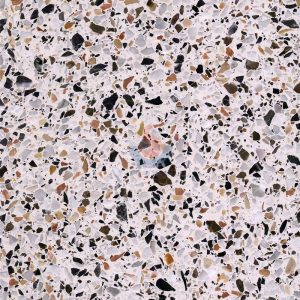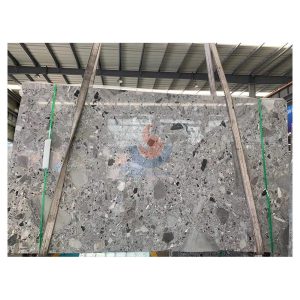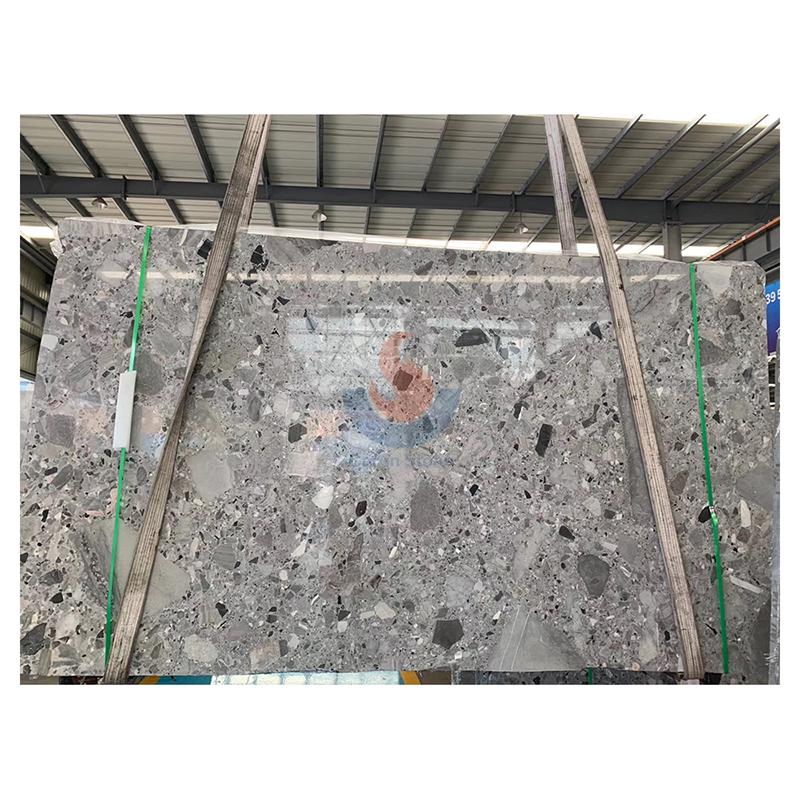Many Chinese friends may be unfamiliar with terrazzo.
Fifty years ago, terrazzo was also popular in China, from national halls to ordinary people’s homes.
But after the 1990s, it was difficult for us to see new terrazzo floors.
It was not until recent years that it made a comeback, and it was not limited to the floor and walls. The “surroundings” covered a wide range, from tables and benches to paper towels and tea cups.

Terrazzo CRW222
Today, let’s talk about this phenomenal Internet celebrity – terrazzo. How did it fall from the altar of China’s national materials, and how did it reborn?
Impressions in China
Terrazzo = soil?
Looking back at the development of foreign countries, we can find that terrazzo has been discovered by designers for its artistic value on the basis of its practical value.
When we look back to China, terrazzo is still more practical.
In fact, terrazzo was introduced to China as early as the Qing Dynasty. We can see a lot of it in the old houses of the Republic of China in Shanghai.
In the early days, terrazzo patterns were mostly our traditional auspicious patterns. With the invasion of foreign powers and the fusion of cultures, terrazzo patterns began to diversify.
The most representative of these is the popularity of Art Deco style. A large number of simple terrazzo patterns that emphasize lines appeared in foreign houses, which still look quite fashionable now.
Then came the early days of the founding of the People’s Republic of China. Everything was in ruins, and the choice of reconstruction materials was very limited.
The materials for paving the floor must be both waterproof and wear-resistant. The only options are marble, granite and other stones or cement.
Cement has poor decorative properties and is easy to crack, so it is not a good choice.
Stone is very expensive in terms of price and cutting and transportation. It is only used in important places such as Chairman Mao Memorial Hall and Monument to the People’s Heroes.
As an aside, tiles were expensive at the time and their appearance was very capitalist. Basically, all the manufacturers that could produce them were out of business, and the only ones left were the plain white bricks.
However, due to the limitation of technology, the tiles at that time were very fragile and would crack when stepped on. Small mosaics could solve this problem, but laying them was too troublesome and only suitable for small areas.
After much thought, the leaders decided to remix and make terrazzo, which is cheaper than big stones and better looking than cement floors.
Therefore, terrazzo is the well-deserved center of the top ten national construction projects such as the Great Hall of the People and the Military Museum.
Beijing Subway Line 1 is also paved with terrazzo. After more than 60 years of trampling by new and old social animals, it has become a little dirty and dim, but still strong.
Gradually, terrazzo has been fully promoted as a public space material, and it has blossomed everywhere in hospitals, schools, parks, government and other units. This has also led to many people’s stereotypes. When terrazzo is mentioned, it is associated with these places and feels ugly and cheap.
Although we now “ignore” terrazzo, in the past, even as a “marble substitute”, people still “cannot afford it”. In order to save money as much as possible, ordinary residential buildings did not use terrazzo that had to be cast on site.
It was not until the 1970s and 1980s that prefabricated buildings represented by Soviet large-scale buildings were rolled out. Terrazzo could be cast in advance in the factory, cut and polished, and then shipped to the site for laying. Terrazzo then flew into the homes of ordinary people.
It was mainly used for window sills and kitchen countertops indoors. In that era, China did not have such a thing as cabinets. Even the stove was built with cement. As one of the few decorative materials in the home, terrazzo was engraved into the DNA of the Chinese people.
This is also why people of the generation of parents now dislike terrazzo and say: “This stuff is what we used in the balcony and kitchen in the past. It’s rustic!”
Another reason for losing favor is that in the early days of reform and opening up, the industry was quite chaotic, and many very crude products also flowed into the market.
There are many pores, it is easy to crack, it absorbs a lot of water, it smells bad after a few mops, the color is also bad, the luster is dull, gray-red and gray-green, the debuffs are stacked, the bad money drives out the good money, and the reputation of terrazzo has collapsed a lot.
After the 1998 housing reform, real estate has led to a surge in building materials. A large number of rough houses need people to spend money to decorate them. Domestic tile technology has also become increasingly mature, and materials that can be put on the ground finally have cheaper and simpler options for construction.
After China’s building materials have experienced a round of industrial upgrading, terrazzo was sent to Ganlu Temple and began to practice in seclusion.

Natural Terrazzo Fossil Grey Marble Big Slab Engineered Size Marble
This is the first half of terrazzo’s life. No matter how you look at it, it is a story of “the previous wave died on the beach”, but who would have thought that 20 years later, the previous wave would turn into a tsunami and sweep the decoration and even the entire design industry again?





